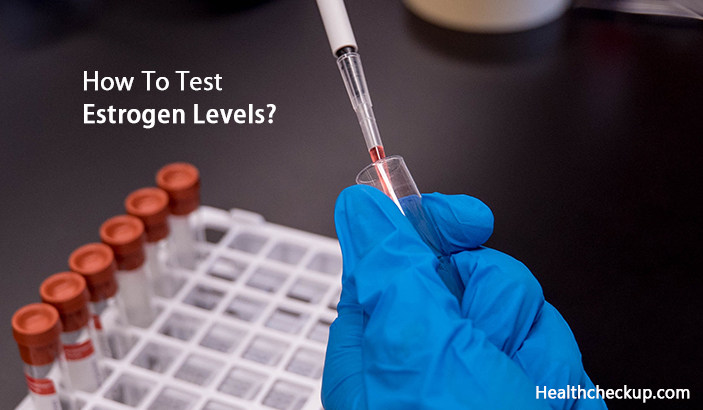What Is An Estrogen Test?
Estrogen tests detect a deficiency or excess of estrogens, usually in a woman. Estrogen tests help diagnose a range of problems related to an imbalance of estrogens in the body. They also help determine the timing of ovulation, and during pregnancy, help in monitoring the health of the baby and the placenta.
We frequently hear about estrogen levels during pregnancy, estrogen levels in menopause. Now, many will have a doubt of “How to test estrogen Levels?”
The estrogen levels can be tested in a blood or urine sample; estrogens can also be tested in saliva.
Estrogens, also called female sex hormones, are a group of hormones that promote and maintain the female characteristics, reproductive functions such as the growth of breasts, uterus and regulate the menstruation cycle. Both men and women produce estrogens but play a key role in the female reproductive system. In men, estrogen is produced at low levels and it is found to affect the sperm count.
There are 3 main types of estrogen that are commonly tested;
- Estrone, also known as E1, is produced by women after menopause
- Estradiol, also called E2, is produced by nonpregnant women
- Estriol, also called E3, increases during pregnancy
How To Test Estrogen Levels?
Estrogen levels are tested in blood, urine, or saliva. A blood test or a urine test is usually done in a doctor’s office or lab, while a saliva test can be done at home.
Urine test not only detects the amount of estrogen in the body but also helps assess how estrogen levels are related to the metabolism, and how the body is using the hormones. The urine sample is collected in the morning or gradually throughout the course of the day.
Saliva test uses home test kits where a person may require collecting several saliva samples at specific times throughout the course of a day. Special instructions mentioned must be followed such as not eating or avoiding certain products such as toothpaste, mouthwash, or tobacco before collecting each sample for a certain period.
Symptoms Of High Estrogen
High estrogen levels can affect men and women differently and may cause a variety of symptoms;
High Estrogen Levels In Women
- Weight gain, especially around the hips and waist
- Bloating
- Breast tenderness or swelling
- Lumps in the breasts that are non-cancerous
- Heavy periods
- Decreased sex drive
- Irregular periods
- Fatigue
- Severe symptoms of PMS (Premenstrual Syndrome)
- Mood swings and depression
- Hair loss
- Difficulty sleeping
- Cold hands and feet
- Headaches
- Memory problems
High Estrogen Levels In Men
- Infertility
- Erectile dysfunction
- Enlarged breasts
What Causes High Estrogen Levels?
Hormonal imbalances can happen in both men and women.
The only estrogen may be produced excessively in the body, or it may occur in conjunction with lowering another hormone in the body such as testosterone or progesterone.
Estrogen levels can increase because of using certain medications. Few examples include;
- Estrogen replacement therapy for treating menopause symptoms
- Hormonal contraceptives
- Some antibiotics
- Certain natural remedies that include the use of herbs
- Phenothiazines used to treat some psychological disorders
Certain health problems can cause an increase in estrogen levels. These include;
- Obesity
- Liver disease
- Tumors in the ovary
High estrogen levels can also run in families.
Symptoms Of Low Estrogen Levels
Women approaching menopause and girls reaching puberty mostly experience low estrogens, but women of all ages can develop a deficiency. Low estrogen can cause several health concerns and symptoms. Some of these include;
- Painful sex because of vaginal dryness
- Infertility because of prevention of ovulation
- Hot flashes
- Missed or irregular periods
- An increase in urinary tract infections because of the thinning of urethral tissue
- Mood swings or depression by decreasing serotonin, a chemical that boosts mood
- Tender breasts
- Headaches
- Trouble with concentration
- Fatigue
- Bone loss, a decrease in bone density causes bones to break easily, making it more vulnerable to bone fractures. Estrogen is required to keep the bones strong by working along with calcium and vitamin D and other minerals.
What Causes Low Estrogen Levels
- Conditions that affect or damage ovaries that are the primary source of estrogen.
- Menopause – Women approaching menopause have a significant risk of having low estrogen.
Other causes include;
- premature ovarian failure
- Severe underweight
- Excessive exercise
- Thyroid disorders
- Turner syndrome, a common genetic disorder of females
- Chemotherapy
- Hypopituitarism (poor-functioning pituitary gland)
- A family history of hormonal problems
Normal Estrogen Levels In Females
The normal levels of estrone and estradiol are as below;
| Estrone | Estradiol | |
|---|---|---|
| Prepubescent female | 29 pg/mL (Undetectable) | 20 pg/ml (Undetectable) |
| Pubescent female | 10–200 pg/mL | 350 pg/ml (Undetectable) |
| Premenopausal woman | 17–200 pg/mL | 15–350 pg/ml |
| Postmenopausal woman | 7–40 pg/mL | <10 pg/ml |
(*pg/ml – Picograms per milliliter)
- Estriol is almost undetectable in non-pregnant women.
- Estradiol levels vary throughout the menstrual cycle in premenopausal girls and women.
Normal Estrogen Levels In Men
Normal estrone and estradiol levels in men are;
| Estrone | Estradiol | |
|---|---|---|
| Prepubescent male | 16 pg/ml (Undetectable) | 13 pg/ml (Undetectable) |
| Pubescent male | 60 pg/ml (Undetectable) | 40 pg/ml (Undetectable) |
| Adult male | 10–60 pg/ml | 10–40 pg/ml |
How To Lower Estrogen Levels In Females?
Doctors may prescribe medications that lower estrogen levels, or if hormone replacement therapy is the cause, the treatment plan may be changed. Surgery (Oophorectomy) may also be performed if required to remove the ovaries.
A few simple lifestyle approaches to decrease estrogen levels are;
1. Nutrition
The body requires magnesium and B vitamins to metabolize estrogen. Consider incorporating these minerals into your daily diet. Foods that contain these are dark leafy greens and vegetables.
2. Sleep
Plenty of sleep (7-9 hours) is required as it affects every aspect of health. Melatonin, a hormone produced by the pineal gland at night, has a key role in overall hormone balance. Adequate melatonin helps in balancing female sex hormones in the body.
3. Eat More Fiber
Estrogen excretion takes place both in the urine and feces. If you take a long time to pass stools, estrogen gets reabsorbed by the body in the process. Eating fiber-rich foods will avoid reabsorption by easing and speeding up bowel movements.
4. Lose Excess Body Fat
A healthy weight is important to maintain hormonal balance. Weight reduction through a balanced diet and exercise decreases the excess fat cells in the body, which produce more estrogen (through the process of aromatization) than required for the healthy functioning of the body.
5. Reduce Stress
Stress is found to increase the levels of estrogen. Consider managing stress by having mindfulness, good sleep, and fitness.
6. Avoid Caffeine
Caffeine is found to affect the estrogen levels and depends on the stage of the menstrual cycle the woman is going through. Avoiding caffeine will help maintain a good hormonal balance.
How To Lower Estrogen Levels In Males?
Here are some tips on how men can rebalance their hormone levels and lower estrogen levels;
- Avoid caffeine, alcohol, and cigarettes that rob testosterone from the body
- Reduce weight by following a ketogenic diet which reduces the excess fat cells that lower testosterone levels by converting it to estrogen.
- Include strength training exercises to your routine to boost muscle mass and testosterone levels
- Reduce everyday stress with moderate regular exercise.
- Get plenty of sleep (around 8 hours)
- Avoid using cleaning products and cosmetics that contain parabens, phthalates (artificial fragrances), and sulfates. Reduce the usage of chemicals by using organic plant-based sprays.
- Consume plenty of organic fruits and vegetables.
How To Increase Estrogen Levels Naturally?
Foods To Eat
- Soybeans – Soybeans or its products like tofu contain genistein, a plant product that mimics the effects of estrogen in the body. These bind to estrogen receptors producing estrogen-like benefits. These plant products are called phytoestrogens.
- Flax Seeds – Flax seeds also contain phytoestrogens called lignans which are helpful in estrogen metabolism.
- Sesame Seeds – Sesame seeds are a dietary source of phytoestrogens and are found to be beneficial based on animal studies.
Vitamins And Minerals
- B vitamins – Are found to create and activate estrogens in the body
- Vitamin D – Plays an important role in estrogen synthesis. Vitamin D supplementation is important in individuals with low estrogen levels.
- Boron – Is a mineral necessary for the metabolism of estrogen. Boron influences the estrogen receptors and allows the body to use the estrogen available in the body more easily.
- DHEA (dehydroepiandrosterone) – Is a natural hormone in the body that is converted to estrogen. DHEA is found to produce the same effects as that of estrogen.
Herbal Supplements
- Black Cohosh – Is a herb that has been used to treat menopause and other menstrual issues. Black cohosh contains compounds that stimulate estrogen receptors and researchers suggest that there are possible beneficial effects.
- Chasteberry – Is a herb that is used to treat gynecological conditions, such as PMS, and is found to exhibit estrogenic effects.
- Evening Primrose Oil – Contains high levels of omega-6 fatty acids and is used to treat PMS and menopause. Studies report that this oil helps reduce the symptoms of lowered estrogen with menopause.
- Red Clover – Contains isoflavones that mimic estrogen in the body. The isoflavones include genistein, formononetin, biochanin A, and daidzein. The studies show red clover supplements to increase the estrogen levels in the body.
- Dong Quai – Is a herb that contains two compounds that contain estrogenic property
Lifestyle Changes
- Exercises – Increasing weight-bearing exercises improve bone health that is affected because of low estrogen levels.
- Decrease Caffeine And Tobacco Intake – Caffeine and tobacco consumption can alter estrogen levels.
With the knowledge on why and how to test estrogen levels, one can easily get the tests done for information about fertility, the health of a pregnancy, menstruation cycle, and a variety of related health conditions.

Vasavi Attada specializes in creating content for Medical/healthcare domain. She has written articles for Indian Health Organization (IHO), American Diabetes Association, and for magazines such as India Today and Dignity Dialogue.
Vasavi Attada holds a Master’s degree in Microbiology from Bangalore University.








